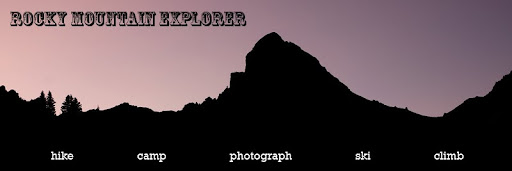I planned to do an adventure race outside Glenwood Springs, CO with my friend Jason from Connecticut the weekend of 11 Sep. I traveled a lot for work this year which means and I ate and drank way too much and exercised very little. Since I wasn’t getting the proper training in to make sure I didn’t die during the race…I wimped out. To make it up to Jason I promised to plan a sweet backpacking trip in the San Juan Mountains. We settled on Labor Day weekend and headed to the Grenadier Range outside Silverton. We drove from Colorado Springs Friday morning, grabbed a bite to eat in Silverton and hit the trail from the Cunningham Gulch trailhead (10,480 ft). This is the Highland Mary Lakes trail which climbs steeply to tree line over the first two miles before it opens onto rolling alpine meadows dotted with beautiful crystal clear lakes (full of trout).
|
| While still in the trees the trail follows close to Cunningham Creek, the steep grade has its benefits – lots of waterfalls |
Once out of the trees, we made our way past Highland Mary Lakes, dropped our packs and setup camp at the second of the two Verde Lakes (12,200 ft).
 |
| Our campsite, tucked into a depression next to the lake. This was the first trip trying out my new tent - the REI Arete 3 (great tent) |
On the second morning we crawled out of the sleeping bags to frosty predawn air and hiked to the summit of an unamed point next to camp to photograph sunrise. From this point we had amazing views of the Grenadier Range with Vestal and Arrow Peaks front and center. To make the morning even better we could hear and see elk bugling far below in the gorge. We also saw a mountain goat skipping across the face of a mountain behind us.
 |
| Dawn in the Grenadier Range |
After a quick breakfast we did a large full day loop that took us to the summit of Whitehead Peak (13,259 ft) and Mount Rhoda (13,402 ft), connecting to the Whitehead trail, past Lost Lake, and over a steep saddle back to camp. We were pretty tired but found the energy to catch some trout before dinner. Jason was pretty mad at me the night before because the fish were hitting my "gaudy" lures left and right but wouldn't touch his flies. He had a better night the second night and I was thinking more about photographing sunset...
 |
| Jason (left) and me on Whitehead Peak. You can see the famous Wham ridge on Vestal from here |
 |
| Hiking the ridge line to the summit of Mount Rhoda |
 |
| Lost Lake from the saddle between the lake and our camp |
I decided to throw my pack on and head back out to a small alpine tarn we found while exploring the ridge above Elk Creek. The wind calmed down and the setting sun lit up the sky - I'm glad I didn't give in to the idea of lounging around camp. As the last light faded from the clouds over Vestal and Arrow, I threw my camera gear in my pack and started hiking fast to scale back down the rock face I had come up before it got too dark. Once in the willows around Lost Lake I was making great time...until I met a momma moose and her baby 40 yards away. It was a tense 60 seconds while we stared at each other figuring out what to do. Fortunately for me, she chose flight over fight and took off up the ridge.
 |
| The tops of Vestal and Arrow Peaks reflected in a secluded alpine tarn |
To get there:
Drive through the town of Silverton and turn onto CO 110 toward Howardsville. In Howardsville (not really a town) turn right onto FR 589. The trailhead is approximately 4 miles up this dirt road. We took my Subaru Outback without any problems but it can be rocky. If you feel like abusing you passenger car, you can make it all the way to the stream crossing just shy of the main parking area.
Route:
Start at the parking area for Cunningham Gulch and Highland Mary Lakes and get ready to sweat. This trail is easy to follow but doesn't give you very many breaks in the first two miles. Once above tree line you will wind in between the Highland Mary Lakes chain. After the lakes the trail tends to fade in and out of the tundra - shoot for the low ridge in front of you, there is a large wooden pole at the top of it. Head for the pole it will get you to a point where you can see Verde Lakes. From here there is a lot of terrain to explore. You can connect with the Continental Divide trail for some extra alpine exploring.
Precautions:
We spent the whole long weekend above tree line. There is no protection from thunderstorms up here so be prepared to seek shelter the best you can. It can be very windy and cold on the exposed tundra - you can get hypothermia from prolonged exposure to the cool wind. Wear wind blocking layers and drink plenty of water. Jason ended up exhibiting some symptoms of mild hypothermia after hiking the Continental Divide Trail all day. I remember saying "J- put on your jacket" and he responded in a yell "NEVER". He was wrapped in his sleeping bag while I filtered what seemed to be gallons of water for him the rest of the day.
 |
| Jason on the way back to the car, the largest of the Highland Mary Lakes in front of him. Old elk antlers strapped to his pack (dont ask) |






















